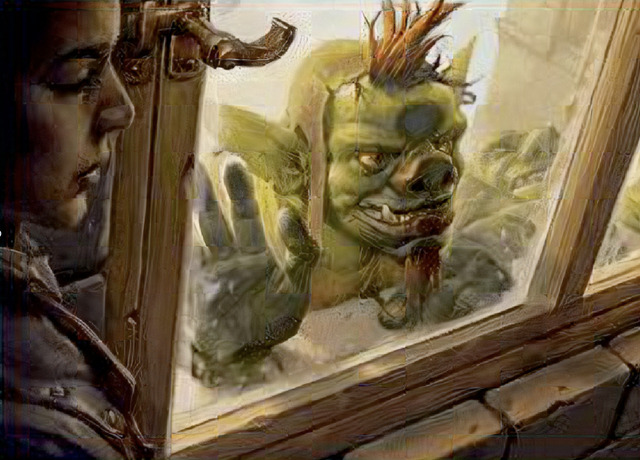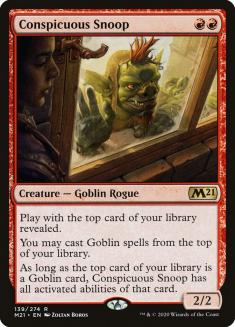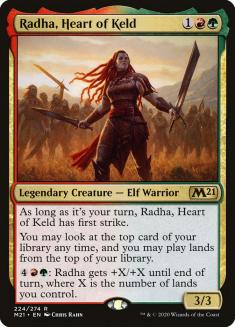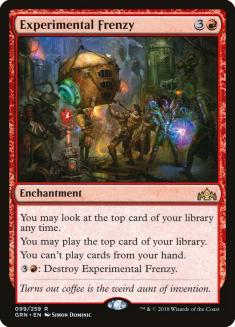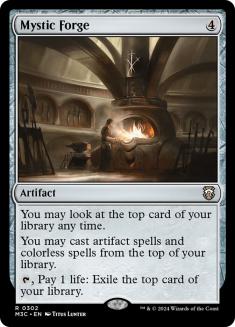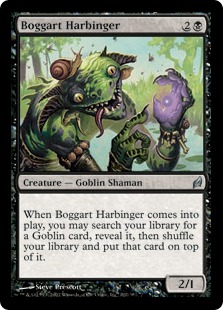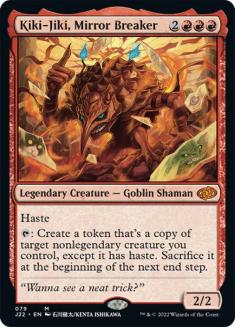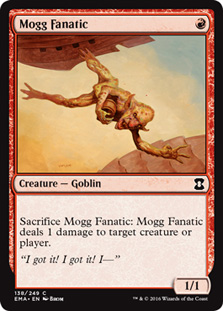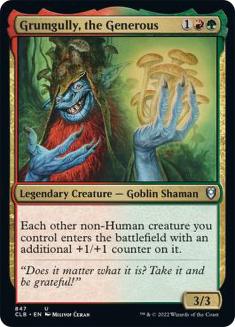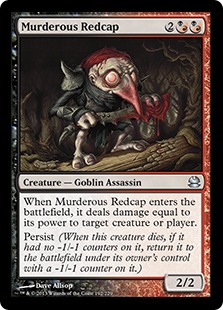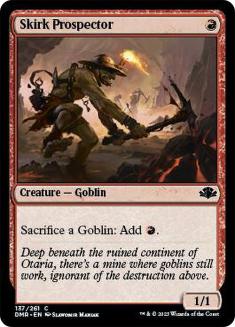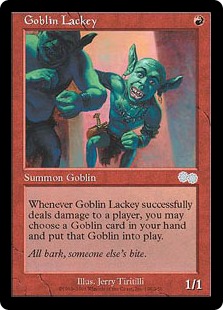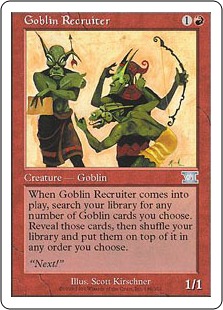Goblins aren’t subtle. Artists and flavour text writers across the years have had a great time finding new ways to convey how hapless and witless Magic’s Goblins are. You’d think the decks built around this motley crew would display a chaotic, all-out aggression. Instead, the Goblins family has included a variety of intricate aggro-combo decks that have made their mark across many formats since the turn of the century.
Core Set 2021 gives this family a new darling:
Preview season can be cruel for fans of tribal decks. Some new Elf or Zombie is previewed and they have high hopes that quickly collide with the reality of modern Magic:
After Ixalan, an entire block built around tribes that were laughably unplayable throughout their time in Standard (until an eleventh-hour assist from Core Set 2020 gave Vampires their day in the sun), it’s wise to be cautious. A whole sandbox of new toys wasn’t enough to make Merfolk playable — if I were a Merfolk fan, I’d pray for a landlocked plane so I won’t get fooled again.
The history of tribal decks in Constructed suggests a few requirements for success:
1. There are enough cheap, strong creatures of that tribe that the deck has a realistic mana curve. Merfolk has enough excellent two-drops to fill out 60 cards by themselves but the lack of good one-drops has always been a fatal flaw. It’s some consolation that this lets Modern or Legacy Merfolk be a good Chalice of the Void deck, but it would really rather not be…
Dragons of Tarkir seemed doomed to fail by this metric — how could a ‘Dragon deck’ work in Constructed when Dragons are usually expensive finishers competing for the few slots that can fill that role? In practice, decks like Mardu Dragons and Esper Dragons were otherwise solid midrange or control shells featuring a handful of Dragons and cards that care about them. Dinosaurs flopped in Ixalan because they didn’t allow decks to adopt a small Dinosaur package like this but also didn’t have the cheap threats to fill out a deck until Marauding Raptor and Rotting Regisaur arrived just before the meteor hit.
2. The tribal aspect has to be more than the sum of its parts by a big enough margin. The ideal trade-off between synergy and raw power is that, when things go right and you put together this Vampire and this other Vampire, you can outmatch whatever the opponent is doing. If your combined forces can’t beat a single Uro, Titan of Nature’s Wrath, why bother?
The same goes for other available synergies. Winding Constrictor plus Walking Ballista not only beat Merfolk A plus Merfolk B but was better against the format at large and didn’t commit you to filling your deck with underwhelming creatures. Occasionally, one tribal payoff is enough to carry the rest of the deck – Sorin, Imperious Bloodlord in Orzhov Vampires comes to mind – but this is rare.
3. The deck needs to have more dimensions than just making some large creatures. Think a fast goldfish if firing on all cylinders, a combo element that wins outside combat, or the ability to interact with the opponent. Tribal decks tend to require a high quantity of creatures as well as specific creatures, which makes it harder to find room for interactive cards in your deck and increases the cost of drawing these cards when they aren’t necessary (as well as the cost of taking a mulligan).
The maxim that beating linear decks requires disruption and pressure is more relevant here as your creatures apply less pressure individually. Humans and Spirits enjoyed success in Modern because they can play as aggressive prison decks — the cards that make the game more difficult for the opponent also shorten it while benefiting from any tribal synergies. Alternatively, Elves in many of its incarnations has bypassed the need for interaction by winning on its own terms with elaborate sequences of game actions.
How well does Goblins meet these criteria in each major format? And how does Conspicuous Snoop fit into the puzzle?
This top-of-library effect has appeared everywhere recently as an experiment with new forms of card advantage — more susceptible to one-for-one interaction than the average Mulldrifter (or Goblin Ringleader) and an opportunity for nuanced incentives in deckbuilding. The strength of these effects is highly contextual but the above three cards are useful examples.
Experimental Frenzy was the perfect curve-topper for a generation of Mono-Red decks in Standard: an unbeatable card in the mirror and a way to grind through the removal, large creatures, and lifegain that were assumed to be good against basic Mountains. A year later, Experimental Frenzy is rarely seen in Mono-Red even as a sideboard card. The shape of the format explains this —there are no aggro mirrors to trump and the Growth Spiral decks quickly overwhelm a Frenzy, but the layout of the Mono-Red decks is important too.
These red decks have to put up with poor one-drops to access more expensive rewards: Anax, Hardened in the Forge; Embercleave; and Torbran, Thane of Red Fell. This bloats the curve enough that Light Up the Stage isn’t the ace it used to be and Frenzy is worse as a result (and, as another four-drop, it makes that problem even worse). It’s no surprise that Mystic Forge is unplayable in Standard, restricted in Vintage, and gets better in between as the size of the format increases and you can build your deck such that one turn with a Mystic Forge translates into many more cards and other colourless threats.
At two mana, Conspicuous Snoop avoids Frenzy’s self-imposed tension and creates a cascade of card advantage remarkably quickly. There aren’t enough Goblins to do this in Standard but Snoop may unlock new frontiers elsewhere:
Creatures (36)
- 4 Goblin Piledriver
- 4 Skirk Prospector
- 4 Legion Loyalist
- 4 Foundry Street Denizen
- 4 Goblin Rabblemaster
- 4 Reckless Bushwhacker
- 4 Fanatical Firebrand
- 3 Goblin Chainwhirler
- 1 Goblin Instigator
- 4 Conspicuous Snoop
Lands (21)
Spells (3)

This list is designed to push Snoop as far as possible, omitting natural fits like Hordeling Outburst or Stoke the Flames. Goblin Rabblemaster / Legion Warboss and Goblin Chainwhirler are popular choices in normal red decks for good reason and Embercleave, with the help of Legion Loyalist, sets up wins out of nowhere with Goblin Piledriver. Chainwhirler, Snoop, and the hope of chaining together several cards with Snoop make Mutavault a risky inclusion, but it’s so strong in any tribal deck that it may be worth cutting Chainwhirler for.
A highly aggressive list like this can win quickly against an empty battlefield, push through a stalled one, and reload in the mid-game via Snoop. This adaptability is impressive but we have to scrape the bottom of the barrel for good one-drops and Fanatical Firebrand hardly counts as interaction. We’d expect a wider range of tools in Modern — Goblin Guide, if not Goblin Lackey — but buried in its oldest tribal block is a card that turns Snoop from an interesting engine card to a lethal threat:
Turn 2 Snoop into Turn 3 Boggart Harbinger sets up an immediate win as follows:
- Boggart Harbinger finds Kiki-Jiki, Mirror Breaker.
- Snoop borrows Kiki-Jiki’s ability and targets itself (a nonlegendary creature), creating a Conspicuous Snoop token with haste. You are now in the same position but with an extra copy of Snoop. Repeat as many times as you like.
- The final Snoop-as-Kiki activation copies Boggart Harbinger, which finds Mogg Fanatic or Sling-Gang Lieutenant. Sacrifice all of the tapped Snoops.
This package is reasonably compact — the combo itself; two copies of Kiki-Jiki, Mirror Breaker as drawing it disables the combo otherwise; and two ‘finishers’ for the same reason. This lets it fit in a deck with no tribal affiliation at all:
Creatures (21)
- 1 Mogg Fanatic
- 2 Kiki-Jiki, Mirror Breaker
- 4 Dark Confidant
- 4 Boggart Harbinger
- 1 Goblin Rabblemaster
- 4 Seasoned Pyromancer
- 1 Sling-Gang Lieutenant
- 4 Conspicuous Snoop
Lands (21)
Spells (18)

Between the best one-mana interaction in Modern and a reasonably easy Turn 3 win, this deck is perfectly suited to fight linear decks, especially other creature combos like Devoted Druid. In longer games, the eight-pack of discard and Unearth help to stick powerful backup threats like Dark Confidant or Seasoned Pyromancer.
Every upstart combo deck these days wants to compare itself to Splinter Twin, which has been rolling in its grave continuously since January 2016. I served with Splinter Twin. I knew Splinter Twin. Splinter Twin was a friend of mine. Snoop, you’re no Splinter Twin. That said, Rakdos Snoop shares the vital characteristics of Twin and other combo-control decks that should stand it in good stead.
This combo’s more obvious home is the Goblins decks that have hovered in the format’s outer orbit since Modern Horizons:
Creatures (34)
- 1 Mogg Fanatic
- 4 Goblin Matron
- 4 Goblin Ringleader
- 4 Skirk Prospector
- 1 Frogtosser Banneret
- 3 Murderous Redcap
- 4 Metallic Mimic
- 4 Munitions Expert
- 2 Sling-Gang Lieutenant
- 1 Pashalik Mons
- 4 Putrid Goblin
- 2 Grumgully, the Generous
Lands (22)
Spells (4)

This build showcases a different combo giving Goblins another angle of attack in Modern:
This follows the same recipe as the Melira, Sylvok Outcast or Vizier of Remedies combo with Kitchen Finks — a persist creature in Putrid Goblin or Murderous Redcap; a way to cancel out -1/-1 counters from persist in Metallic Mimic or Grumgully, the Generous; and a free on-demand way to sacrifice creatures in Skirk Prospector or Sling-Gang Lieutenant.
At first glance, the Conspicuous Snoop combo is a substantial upgrade over the persist package, as it requires two cards instead of three and fewer narrow cards. Some shell could support both combos and focus on assembling either as soon as possible, but I’d focus on the newer and better one:
Creatures (30)
- 1 Mogg Fanatic
- 4 Goblin Matron
- 2 Kiki-Jiki, Mirror Breaker
- 3 Goblin Ringleader
- 4 Skirk Prospector
- 2 Mogg War Marshal
- 4 Boggart Harbinger
- 4 Munitions Expert
- 1 Sling-Gang Lieutenant
- 1 Pashalik Mons
- 4 Conspicuous Snoop
Lands (24)
Spells (6)

As all-stars from the glory days of Goblins got reprints and Modern Horizons added intriguing new Goblins to the mix, these decks doubled down on their strengths but couldn’t patch up their fundamental weakness — playing fair in a format that often isn’t about that and not having the pressure to back up the smattering of interaction it could afford to play. The Conspicuous Snoop combo gives Goblins the chance to race any deck in the format with Goblin Matron adding redundancy if time allows.
Opponents need cheap removal against the threat of the combo but Goblin Ringleader and token creators can push through this effectively in normal games while Aether Vial dodges counters and immediately leverages the card advantage from Matron or Ringleader in the mid-game. Munitions Expert and Pashalik Mons are nightmares for opponents hoping to win via combat or creatures more generally.
Conspicuous Snoop may breathe new life into another Goblins shell inspired by a blast from the past:
Creatures (22)
- 4 Goblin Matron
- 4 Goblin Warchief
- 1 Goblin Sharpshooter
- 4 Goblin Piledriver
- 4 Skirk Prospector
- 1 Goblin Sledder
- 4 Mogg War Marshal
Lands (19)
Spells (19)

After its fifteen minutes of fame in Extended, Fecundity has enjoyed a long and happy retirement. Similar to Elves Combo fuelled by Glimpse of Nature and Heritage Druid, this deck uses Skirk Prospector with Fecundity to turn every Goblin into a Manamorphose and Mogg War Marshal into Dark Ritual + Ancestral Recall. With this setup, Empty the Warrens is the best source of cards and mana any combo deck could ask for; without it, Empty’s usual play pattern of flooding the battlefield with creatures on Turn 2 or Turn 3 is still enough to win many games.
Goblins enthusiasts tried to revive this deck when Dominaria reintroduced Skirk Prospector, to little success. With Rite of Flame and Seething Song in permanent exile from Modern, the mana and the Skirk Prospector engine relied too heavily on Fecundity. Conspicuous Snoop allows you to build a large storm count for Empty the Warrens by casting ‘free’ Goblins with Prospector, and careful sequencing of Fecundity triggers can clear out non-Goblins from the top of the library to ensure a steady stream of hits. Unfortunately, the lack of other fast mana may be an insurmountable obstacle.
Zooming out even further, we find a home for Snoop in Legacy. Goblins was a dominant force in Legacy when the format was given that name and divorced from Vintage in 2004 — it was outmoded long before 2019 shook Legacy like a snow globe with every new release. Despite that, Goblins devotees can still hold their own:
While the competition is much stronger in Legacy and the Snoop combo no longer races the other combo decks, Goblin Lackey is not only a much-needed one-drop but a card that can run away with games with just one attack. Fifteen years ago, Turn 1 Lackey throwing out a Turn 2 Siege-Gang Commander was one of the scariest openings in the format. Now, Conspicuous Snoop offers a whole new tree of Lackey lines:
- Turn 1: Goblin Lackey.
- Turn 2: Goblin Lackey connects and triggers, putting Goblin Matron onto the battlefield. Matron finds Snoop; we cast Snoop.
- Turn 3: If we have Boggart Harbinger, we can threaten a win; otherwise, another Lackey hit with a second Matron or Kiki-Jiki also threatens a win.
Notably, Goblin Lackey lets Goblin Matron and Goblin Ringleader slot into these fast combo starts to increase consistency. We now have Snoop nut draws as well as Lackey nut draws (or Vial draws, against blue decks where that’s the most relevant card).
Our brief visit to the early 2000s takes a detour through Extended and Vintage, where Goblin Recruiter enabled wins from out of nowhere via Food Chain or the on-brand Goblin Charbelcher in otherwise normal Goblins decks. Goblin Recruiter was banned in Legacy from the format’s creation (and that definitely isn’t changing now) but might tempt you to enlist in some Vintage queues on Magic Online with Snoop’s help:
- Turn 1: Mox Ruby, Goblin Recruiter, order: Conspicuous Snoop; Torch Courier; Kiki-Jiki, Mirror Breaker
- Turn 2: Cast Conspicuous Snoop; use it to cast Torch Courier from your library; activate Courier to give Snoop haste; make copies of Snoop via Kiki-Jiki; copy Goblin Recruiter, finding Mogg Fanatic.
Snoop turns Goblin Recruiter into a relatively mana-efficient one-card combo. This may seem completely outmatched in Vintage but the texture of the format gives some cause for optimism. The fair blue decks in Vintage are surprisingly vulnerable to resilient aggression protected by Cavern of Souls. Workshop Aggro is an uphill battle but can be fought with a stack of Null Rods and searchable haymakers like Goblin Trashmaster.
Conspicuous Snoop is a card with a lot of potential that forces you to think about it. For a tribe that loves attention as much as Goblins, what more could a preview card ask for?

